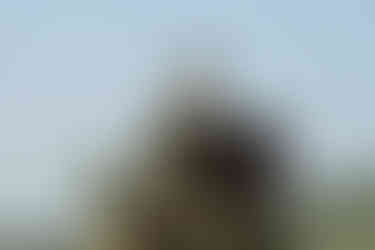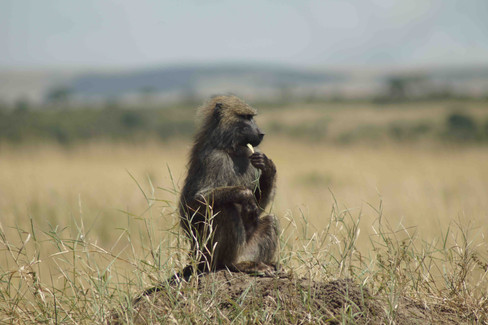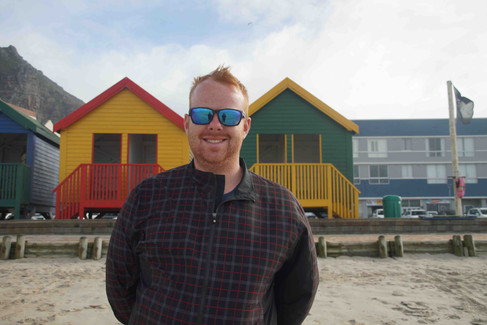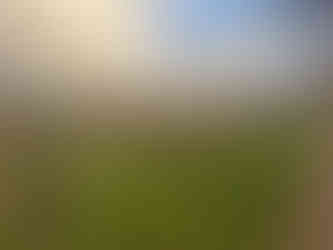Summer Adventure: Week 53, July 23-29, 2023
- Katie & Webster
- Jul 30, 2023
- 8 min read
We have had quite the week filled with so many adventures!
On Sunday, we did a full day excursion to the Tanzanian border to see the Great Migration. Alex, our guide, maneuvered more than 150km each way (~3 hours) to see thousands of animals cross the river on their journey to Kenya. Every summer millions of wildebeests, zebras, and topi antelope migrate from Tanzania to Kenya. While scientists aren’t 100% sure why this happens, it is clearly engrained their DNA. Baby zebras, as young as 3 months old, were migrating with the herd. We drove from camp, to the main entrance to the Maasai Mara National Park. The National Park is owned and operated by the government meaning we had to pay visitor fees to enter. Upon entering the park we began to see thousands of animals who had already crossed the river and were well on their way North to Kenya. Then, we drove towards the main river crossing and waited. We had a nice picnic lunch with Alex, chatted, and waited to see the magic happen. We were lucky to see three river crossings with wildebeests, zebras and antelope. Sadly, two crocodiles got lunch and took down two zebras. It was quite something to watch! Our drive back to camp was much quieter after our ten hours of sightseeing. Alex got us back in time to shower before dinner - the dust out there is no joke!
On Monday we spent our day doing game drives in the conservancy close to the camp. Alex and Vivian took us out twice, for 3-hour drives, thank you Alex & Vivian! The Maasai Mara is a huge area where animals can roam freely. The main park is owned and operated by the government - this is where we saw the great migration. However, around the main park, different families and communities have donated their land to extend the space given to animals - these are called conservancies. The conservancies are managed by local communities providing jobs to those who have lived and worked on the land for generations. Animals thrive in these places because those who are most knowledgeable about their patterns and needs are caring for the environment around them. Since our camp was on a private conservancy, we never saw any other cars. We could enjoy the wildlife and landscapes in peace. On Monday, we were lucky to see some big cats! We saw a pride of lions and a cheetah.
On Tuesday, we went for a morning game drive bright and early. We saw some elephants, zebras, and wildebeests.
In the afternoon, Alex and Vivian took us to visit Tobi and Laura’s school just outside the Mara conservancies. Tobi was my in-country facilitator in 2014 and has since opened his own school for his community with Laura. They provide life changing education to 100 students from daycare age-grade 5. The school is a labour of love, with many students boarding on school grounds, and local Mammas cooking breakfast, lunch and dinner. We had the opportunity to meet all the students, check out their classrooms, and have a discussion with the grade fives about their educational journey. We were so impressed with how well behaved, and articulate they all were. I still can’t believe they all speak three languages! They had lots of questions, were keen to teach us what they were learning, and loved to hear about our cold Canadian winters.
Most schools in Kenya require students to come with books, pencils, pens, etc which often leads to an inequity between those who can afford to bring supplies, and those who can’t. At Encheshoroi School everything is provided - pencils, pens, books, breakfast, lunch, a playground. Tobi and Laura hope this reduces inequality in the classroom - when their students walk in the door everyone is on an equal playing field. The school supplies our community donated were passed along to Tobi and Laura for their students. Thank you again to everyone who contributed! During our visit, the students were using the sports balls on the field, drawing pictures of dinosaurs from the books we brought, and doing math with the pencils.
At the end of our visit, Tobi surprised us with some homemade chapati, a local favourite. It was amazing to see what they have built from the ground up, literally.
That night we returned back to camp and were surprised by our favourite in-house staff, Jemmimiah and Dennis. Jemmimah and Dennis were always around at camp chatting with us, teaching us African board games, and asking the chef to make us special dishes to try. We spent hours chatting with them both, learning about their backgrounds, their communities, and their culture. On our last evening, Jemmimah and Dennis organized a private dinner overlooking the hippo river for us! We had a private BBQ, a campfire, and all of our favourite dishes from our stay. It was an amazing way to end our last evening at camp. Thank you, thank you, thank you Jemmimah and Dennis!
On Wednesday morning we went out with Alex and Vivian for one last game drive. We finally saw a leopard, but then spent most of the drive just chatting.
In the afternoon, we checked out and headed for the airstrip. Our friends Alex and Vivian drove us to the plane. I can’t describe what it was like but imagine a dirt road surrounded by trees, zebras and antelope. Everyone on our plane, all 16 of us, had been driven to the airstrip so about 6 cars were parked just outside the dirt road on the grass, each from a different lodge. Before our plane could land, a park ranger drove down the air strip to clear off all the animals! We boarded the smallest plane … about the size of a small moving van with 16 of our closest friends. There was no air conditioning, no speakers, no bathrooms, no door between the cockpit and the seats (which were like folding chairs) … it was an experience. As we took off, Alex and Vivian were the only two people left waiting by the air strip to wave goodbye.
We landed back in Nairobi and headed to our hotel for the evening. When we arrived we were upgraded to a huge suite! Since the hotels were the same brand in both the Mara and Nairobi… we think our great friends in the Mara might have had something to do with it :) We enjoyed some time at the pool and ordered room service before bed.
Webster’s Note on Kenya By far the best part of our experience in Kenya was the people. Kenyan hospitality is truly unmatched anywhere else we have travelled. On our safari we got to know Alex, Vivian, Jemmimiah and Dennis very well, plus all of the other staff members. Learning their stories, culture and background was incredible; they truly made our visit special. The warmth of the people goes beyond those reliant on tourism. Just driving down the street, locals will drop what they are doing to smile and wave at you. Kids run after the car just to say hello. While the animals in the Mara are awesome, the people are what truly made our time in Kenya special.
On Thursday, we were up bright and early for a flight out of Kenya to Cape Town! We drove back to the big airport we flew into 9 days ago (with much less luggage, now that the school supplies were being used!) and flew 6 hours from Nairobi to Cape Town. We picked up a rental car and headed to our hotel in the city.
On Thursday night, we enjoyed some time walking around the V&A Waterfront. The V&A is the oldest working harbour in South Africa that is now surrounded by 80 restaurants, countless shops, grocery stores, movie theatres and more. It also doubles as the Cape Town Cruise Terminal so there were lots of local street buskers playing music and dancing.
On Friday, we woke up to some cold and rainy weather. Webster headed our for a guided hike at Lions Head mountain in Cape Town. Lion's Head peaks at 669 metres above sea level. The peak forms part of a dramatic backdrop to the city of Cape Town and is part of the Table Mountain National Park. He hiked for 4 hours to the top to watch the sunrise. It was a cloudy day with lots of views in the clouds.
In the afternoon, we wandered through the Old Biscuit Mill, an old factory turned into a modern retail/restaurant space. We bought some cool little things, and had a great lunch at How Bao Now.
Later in the day, we spent time walking around the Bo-Kaap neighbourhood. Bo-Kaap is a popular daytime destination, known for its narrow cobbled streets lined with colourful houses.
The Bo-Kaap neighborhood was first developed in the 1760s by Dutch colonialist Jan de Waal, who built a series of small rental houses to provide accommodation for the city’s Cape Malay slaves. The Cape Malay people originated from the Dutch East Indies (including Malaysia, Singapore and Indonesia), and were exiled by the Dutch to the Cape as slaves towards the end of the 17th century. Some of them were convicts or slaves in their home countries; but others were political prisoners from wealthy, influential backgrounds. According to legend, the rental terms of de Waal’s houses stipulated that their walls must be kept white. When slavery was abolished in 1834 and the Cape Malay slaves were able to purchase their homes, many of them chose to paint them in bright colors as an expression of their newfound freedom. Bo-Kaap (which was originally called Waalendorp) became known as the Malay Quarter, and Islamic traditions became an intrinsic part of the neighborhood’s heritage. It was also a flourishing cultural center, because many of the slaves were skilled artisans. During the apartheid era, Bo-Kaap was subject to the Group Areas Act of 1950, which enabled the government to segregate the population by declaring separate neighborhoods for each race or religion. Bo-Kaap was designated as a Muslims-only area, and people of other religions or ethnicities were forcibly removed. In fact, Bo-Kaap was the only area of Cape Town in which Cape Malay people were allowed to live. It was unique in that it was one of the few city center locations designated for non-whites: most other ethnicities were relocated to townships on the city’s outskirts.
We spent time walking around the neighbourhood and then through a small museum detailing the history of the community.
We enjoyed some time at the hotel in the early evening before heading to Scala Italian for dinner. We had some great dishes, all tapas style to share.
On Saturday, we started our day at Muizenberg, one of the most popular surfing beaches in Cape Town. One of the most famous things are the beach huts along the beach - these were used hundreds of years ago as changing rooms. Now, they have been refurbished and are popular spots for people to take photos.
Later in the day, we toured wineries just outside Cape Town. Constantia is one of the oldest neighbourhoods in Cape Town, home to a variety of wineries among the rolling hills and mountains. Our first stop was Klein Constantia, a large, industrial style winery where we had a wine tasting of 5 wines, grown, made & bottled at Klein Constantia.
Our second stop was Groot Constantia-Trust, who claim to be the oldest winery in Cape Town. We had a wine + chocolate tasting where the sommelier paired wines with handmade local chocolates.
Our third stop, was Constantia Glen where we both tried wines grown, made, and bottled at Constantia Glen. We enjoyed the warm, friendly environment at Glen. We ended our night with an Uber back to our hotel. Our Uber driver’s name was Webster! Webster loved meeting another person with the same name for the first time ever :)
This week, we have a few more days in Cape Town before heading out to Kruger National Park to see some more animals! We are hoping to see lots of elephants and big cats.































































































































































































































































































































































































































































































































































Comments